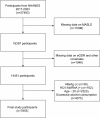Association between eGDR and MASLD and liver fibrosis: a cross-sectional study based on NHANES 2017-2023
- PMID: 40520791
- PMCID: PMC12162473
- DOI: 10.3389/fmed.2025.1579879
Association between eGDR and MASLD and liver fibrosis: a cross-sectional study based on NHANES 2017-2023
Abstract
Background: This study aimed to investigate the association between estimated glucose disposal rate (eGDR) and metabolic dysfunction-associated steatotic liver disease (MASLD), as well as liver fibrosis, using data from the National Health and Nutrition Examination Survey (NHANES) 2017-2023 dataset.
Methods: Data from 7,855 participants in the NHANES 2017-2023 dataset were analyzed. Multivariable logistic regression models were constructed to assess the association between eGDR (both continuous and quartiles) and MASLD, as well as liver fibrosis, adjusting for potential confounders. Generalized additive models (GAM) were used to explore non-linear relationships, stratified by age, hypertension, diabetes, cardiovascular disease (CVD), and body mass index (BMI). A two-piecewise linear regression model was used to examine threshold effects. Subgroup analyses were conducted to assess effect modification. Mediation analysis was performed to determine the role of the atherogenic index of plasma (AIP). Sensitivity analysis was performed to test the robustness of the results.
Results: In the fully adjusted model, higher eGDR was inversely associated with both MASLD and liver fibrosis (MASLD: OR = 0.62, 95% CI: 0.53-0.72, p < 0.0001; liver fibrosis: OR = 0.50, 95% CI: 0.42-0.58, p < 0.0001). Participants in higher eGDR quartiles (Q2, Q3, and Q4) had progressively lower odds of both MASLD and liver fibrosis compared to those in Q1 (MASLD: Q2: OR = 0.56, 95% CI: 0.37-0.84, p = 0.0047; Q3: OR = 0.25, 95% CI: 0.12-0.50, p = 0.0001; Q4: OR = 0.13, 95% CI: 0.05-0.31, p < 0.0001; liver fibrosis: Q2: OR = 0.24, 95% CI: 0.13-0.44, p < 0.0001; Q3: OR = 0.06, 95% CI: 0.02-0.16, p < 0.0001; Q4: OR = 0.05, 95% CI: 0.01-0.19, p < 0.0001). A non-linear relationship with threshold effects at an eGDR value of 3.25 was observed for MASLD. Subgroup analyses revealed that the inverse association between eGDR and MASLD was more pronounced in individuals without diabetes. Additionally, smoothing curve fitting showed that the dose-response relationship between eGDR and both MASLD and liver fibrosis differed by metabolic and clinical status. Mediation analysis suggested that AIP partially mediated the association between eGDR and MASLD, accounting for approximately 10.6% of the total effect. Sensitivity analyses excluding extreme eGDR values confirmed the robust inverse associations with MASLD and liver fibrosis.
Conclusion: This study found a significant non-linear inverse association between eGDR and both MASLD and liver fibrosis, with a threshold effect observed for MASLD. The association was stronger in non-diabetic individuals and partially mediated by AIP. Moreover, the dose-response relationships varied across metabolic and clinical subgroups.
Keywords: MASLD; NHANES; cross-sectional study; diabetes; eGDR; insulin resistance.
Copyright © 2025 Peng, Li and Fu.
Conflict of interest statement
The authors declare that the research was conducted in the absence of any commercial or financial relationships that could be construed as a potential conflict of interest.
Figures




Similar articles
-
The association between estimated glucose disposal rate and metabolic dysfunction-associated steatotic liver disease and liver fibrosis in US adults.BMC Endocr Disord. 2025 Mar 11;25(1):67. doi: 10.1186/s12902-025-01891-7. BMC Endocr Disord. 2025. PMID: 40065306 Free PMC article.
-
The relationship between the ratio of non-high-density lipoprotein cholesterol to high-density lipoprotein cholesterol (NHHR) and both MASLD and advanced liver fibrosis: evidence from NHANES 2017-2020.Front Nutr. 2025 Feb 27;11:1508106. doi: 10.3389/fnut.2025.1508106. eCollection 2025. Front Nutr. 2025. PMID: 40084133 Free PMC article.
-
Association of estimated glucose disposal rate with incident cardiovascular disease under different metabolic and circadian rhythm states: findings from a national population-based prospective cohort study.Diabetol Metab Syndr. 2024 Oct 30;16(1):257. doi: 10.1186/s13098-024-01494-7. Diabetol Metab Syndr. 2024. PMID: 39472994 Free PMC article.
-
Metabolic dysfunction-associated steatotic liver disease, insulin sensitivity and continuous glucose monitoring metrics in patients with type 1 diabetes: A multi-centre cross-sectional study.Diabetes Obes Metab. 2025 Jun;27(6):3201-3211. doi: 10.1111/dom.16333. Epub 2025 Mar 13. Diabetes Obes Metab. 2025. PMID: 40083078 Free PMC article.
-
Estimated Glucose Disposal Rate Predicts the Risk of Incident Metabolic Dysfunction-Associated Steatotic Liver Disease.Endocr Pract. 2025 Apr;31(4):479-485. doi: 10.1016/j.eprac.2025.01.002. Epub 2025 Jan 15. Endocr Pract. 2025. PMID: 39818319
Cited by
-
Association between estimated glucose disposal rate and metabolic dysfunction-associated steatotic liver disease and dyslipidemia in US adults: a cross-sectional study.Front Nutr. 2025 Jul 2;12:1621074. doi: 10.3389/fnut.2025.1621074. eCollection 2025. Front Nutr. 2025. PMID: 40672413 Free PMC article.
References
-
- Rich NE, Oji S, Mufti AR, Browning JD, Parikh ND, Odewole M, et al. Racial and ethnic disparities in nonalcoholic fatty liver disease prevalence, severity, and outcomes in the United States: a systematic review and Meta-analysis. Clin Gastroenterol Hepatol. (2018) 16:198–210.e2. doi: 10.1016/j.cgh.2017.09.041, PMID: - DOI - PMC - PubMed
LinkOut - more resources
Full Text Sources
Miscellaneous

